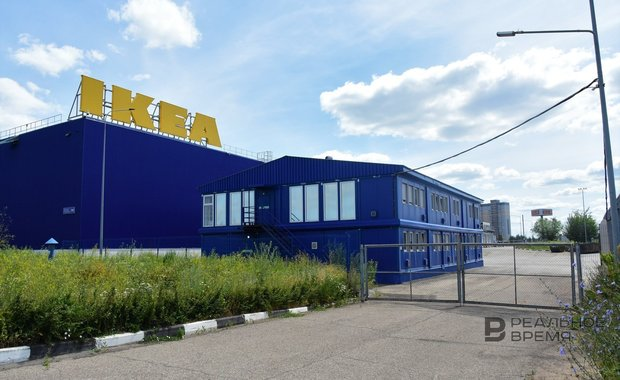Big retailers go to regional shopping malls
How chain stores expand and what brands hope for when opening stores in towns
The coronavirus pandemic, the start of the Russian special operation in Ukraine and the following exit of Western companies upended the life of large Russian malls. At the same time, this crisis provided Russian and remaining foreign brands new opportunities to develop and grow. A number of such tenants in shopping malls note a rise in traffic and operational revenue in the last months. A shift of big retailers to regional shopping malls is another positive tendency. Read more about the situation in the commercial real estate market in Realnoe Vremya’s report.
Three troubles of malls in million-plus cities
The last 2,5 years have dramatically changed the lives of tenants and managers of big malls in big cities and regional million-plus cities. And not for the better. Three key problems can be singled out that make many shopping malls seriously think about changing their format today.
- The coronavirus pandemic and self-isolation suddenly stimulated the development of e-commerce. While malls were closed for several months and then had to let clients in only with QR codes, online retailers improved their services, developed delivery and increased the share in the market. As a result, according to different data, up to 25% of all non-food products in cities are bought online today. Moreover, the liberalisation of shopping and the cancellation of masks didn’t change the situation: people already felt the convenience of e-commerce. Traffic in shopping malls decreased.
- The events on 24 February influenced the operation of large shopping centres more: Western brands started to leave Russian en masse by closing their stores. According to the data provided by Yelena Stryukova, development and use director of the Commercial Realty Department at Essen Production AG, up to 24% of the areas is free (after the news about the exit of H&M and IKEA). Some tenants cease operations not because belong to Western consortiums but for other objective reasons: for instance, it is cinemas that in fact have nothing to show and that have occupied significant areas in many big shopping centres.

Photo: Maxim Kokunin/realnoevremya.ru - Large shopping malls cannot significantly reduce the rent, otherwise, their operational profitability will be questionable. This complicates the selection of tenants for vacant areas: a second IKEA will unlikely appear in the foreseeable future.
What is death for a Western brand is good for a Russian one
But the situation is developing positive for Russian brands and those Western brands who continue working in Russia. In Essen’s shopping malls (39 shopping centres in 27 Volga cities), some tenants among big Russian brands note a rise in traffic and operational revenue: indicators tripled after some Western fashion brands stopped working in Russia.
As Development and Use Director of the Commercial Realty Department at Essen Production AG Yelena Stryukova notes, the closure of stores of some chain doesn’t mean consumption falls. People still need something to eat, somewhere to buy clothes, furniture. Therefore demand redistribution is plain to see. And those chains that manage to fit in this global and large-scale process will be at an advantage in the next years.

Make way for regional shopping malls!
There is an interesting fact: today big retailers bet not only million-plus cities. Some chains are actively entering towns. This applies to both the fashion segment and electronics stores. The tendency is global, and it can be seen in the example of the same chain of shopping malls owned by Essen Development — the Commercial Realty Department of Essen Production AG. The company manages 39 shopping centres in 27 cities of the Volga area, moreover, they specialise in regional centres, not big cities: facilities in Belebey, Agryz, Nizhnekamsk, Naberezhnye Chelny, Chistopol, Novocheboksarsk...

And here the situation after the pandemic and February events is very different from the situation in shopping malls in million-plus cities. Traffic grows — it reached pre-pandemic indicators in April, while the share of vacant areas after the closure of international brands is less 1%. Yelena Stryukova explains why:
“The situation with the closure of stores of international brands almost didn’t affect regional shopping malls and facilities in cities with the population from 50,000 people. Tenants of shopping centres in districts and microdistricts traditionally rested on local businesses. Traffic in such facilities returned to numbers registered earlier this year by April and even a bit surpassed numbers of 2021 (10-15%).”
We will add that besides the stable flow of buyers in regional shopping malls, here the rent rate is much lower (compared to regional capitals, for instance, the same Kazan). Therefore big Russian chains choose big areas in such shopping malls today. Food supermarkets are anchor tenants in such centres. Also, discounter chains that seriously compete with federal and international giants such as DNS, Kari or Sinsay, which closed in mid-April but opened again in May and got a full house immediately after the opening, actively go there).
Eduard Tishko, director general of LCM Consulting, noted as early as early summer:

“The rate in small cities is two and even three times lower than in Kazan”
The office of one of the biggest Russian shoe chains Kari explains the mechanism of their “regional expansion” to us:
“First, our strategy was designed for both million-plus cities and small cities with the population of some 50,000 people. Of course, the area and assortment in these two formats will differ. In towns, the store area is from 800 square metres, and the assortment is focus on shoes for the whole family, accessories and related products. In big cities, we open hypermarkets on an area of 1,500-3,000 square metres with a wide range of shoes, bags, accessories for the whole family, goods for kids (clothes, toys, transport), with a big jewellery department, products for home and cosmetics.”
Artemy Makarov, vice director general of development at DNS in the Volga Division, explains that the work on the development of the chain constantly goes on, the company works on formats and looks for locations where DNS would be interesting for buyers. Today stores of the chain in different formats are present in every big settlement of Tatarstan, moreover, not 50,000 but 10,000 people are the cut-off point of the chain.
“The rent rate is a critical term for us. The average rate in small cities is two or even three times lower than in Kazan. Perhaps this is the main factor that allows opening and supporting stores in towns,” says Artemy. “Obviously, the opening of stores in the locations not occupied by opponents has some advantages. Even through the turnover of such stores is 5-6 times lower than the stores in a big city, we manage to keep the balance between income and costs with such turnovers thanks to small areas and cheap rent.”
The Russian chain Gloria Jeans continues opening in small cities, talks are held with many other big retailers that are interested in appearing in small shopping centres.
As Yelena Stryukova says, the practice shows that in Essen shopping malls, other chains come instead of the tenants that close for geopolitical reasons (another international brand called us the next day after the announcement of the closure of H&M stores in Russia and offering to get the vacant areas).
“In this light, from a perspective of investments in commercial realty, we see prospects precisely in the niche of small regional shopping malls,” the expert concludes.